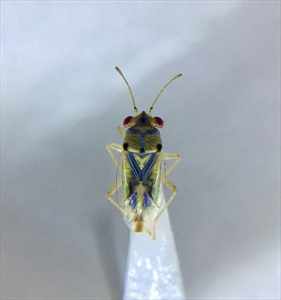- Worldwide distribution. Reported from Australia and Fiji. Prey includes aphids, hoppers, mirids, mealybugs, thrips, whiteflies, small caterpillars, and spider mites. Prey is stabbed, enzymes injects, contents sucked out.
- Eggs laid singly, or in clusters on leaves or stems near prey.
- Biocontrol: nymphs and adults predators, surviving on nectar and pollen (and seeds) when prey scarce.
- Adults, 5-6 mm long, broad heads, bulging eyes, piercing-sucking mouth parts, forewings create triangular pattern when closed.
- Management: studies in USA used crimson clover or vetch cover crops interplanted with cash crops - bugs migrate to cash crop as cover crop dies; plant sunflower to support bugs with seed when populations low; most importantly, do not use broad-spectrum insecticides, instead preserve Geocoris populations by: (i) microbial pesticides: spinosad or Bt; (ii) botanical pesticides: neem; or (iii) pheromones (if available).





